The second session was the Northeast Region Pasture-Based Research & On-Farm Demonstration Update. Dr. Andre Brito, UNH Assistant Professor of Organic Dairy Management, moderated the session. This perennial session highlights current activities in pasture research and demonstration.
Dr. Howard Skinner, USDA-ARS, University Park, PA was the first presenter filling in for Dr. Sarah Goslee who had unexpected conflict. The title of the presentation was Northeast Ryegrass Cultivar Trials. This was a thought-provoking presentation and a needed departure from typical forage agronomics of looking mainly at yield comparisons among cultivars of a grass species under limited stress. Six perennial ryegrass cultivars were compared in greenhouse trials: Kilrea, Barutti, Mara, Remington, Barelan, and Barnhem.
The cultivars were grown for 63 days, clipped to simulate grazing, and sampled at 1 week and 4 weeks after clipping. The cultivars were grown under 4 conditions: Well-watered, high nitrogen; Drought stress, high nitrogen; Well-watered, low nitrogen; and Drought stress, low nitrogen. For this 10-minute presentation, Dr. Skinner presented just the plant size (root + shoot mass) of three-month-old plants, 1 month after clipping.
From these root and shoot mass findings, the take-home message was:
- Cultivars differ in size.
- Cultivars respond differently to nitrogen levels and to drought stress.
- High performance (yield) under good conditions does not correlate with stress tolerance.
Kilrea was the cultivar that performed best under both drought and low nitrogen stress, but was the lowest producer under well-watered and high nitrogen than the other 5 cultivars. Two cultivars, Mara and Barnhem, that performed well under well-watered, high nitrogen conditions, yielded significantly less under drought and low nitrogen conditions than Kilrea. Barutti, Remington, and Barelan were intermediate between Kilrea and the 2 cultivars, Mara and Barnhem.
In a pasture setting that is usually nitrogen-limited and suffers from drought conditions from time to time, Kilrea may be a better choice as it will perform better under stress. Nitrogen fertilizer is costly and sparingly used on pastures. A high yielding cultivar under optimal fertilizer and soil water may not survive in the pasture setting. A dead or struggling plant does not live up to its research test plot promise when pampered during testing.

Ms. Alison Grantham, doctoral candidate from Penn State University, gave the second presentation of this session, Nitrogen Availability, Retention, and Loss in Annual and Perennial Organic Pastures in PA. It focused on a comparison of nitrogen (N) dynamics in annual (sorghum sudangrass [SSG] + red clover [RC]) and perennial (orchardgrass [OG] + red clover) pastures on organic farms.
Certified organic pasture has increased in acreage dramatically since the Pasture Rule for organic dairy farms was adopted by the National Organic Program. New York, Vermont, and Pennsylvania lead the Northeast Region in pastureland acreage growth. At the same time, due to global climate change, there has been an increase in extreme rainfall events during the Fall season over the past 63 years. Managing nitrogen in grazed organic systems in a region with increasing extreme rainfall events is challenging. Having enough N to grow forage can be especially challenging in organic systems since synthetic chemical fertilizers cannot be used.
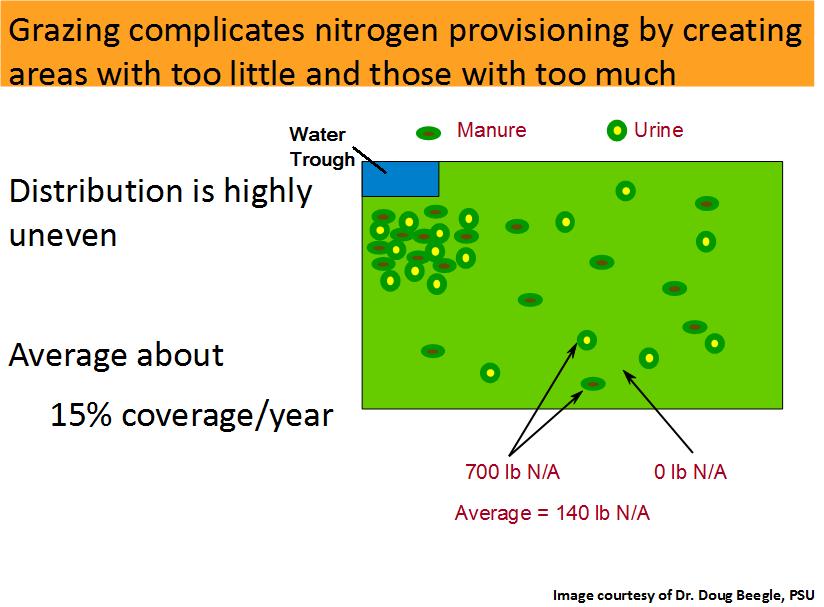
Grazing complicates nitrogen provisioning by creating areas that have too little and areas that have too much N due to spot placement of urine and dung. Manure and urine spots in the pasture may run as high as 700 pounds of N/acre while the rest of the pasture may have only a few pounds of N/acre. The distribution of the manure and urine is often very uneven being highest near water troughs, hay feeders, and shade and lightly scattered in the rest of the pasture.
The experiment simulated grazing by clipping. It looked at nitrogen dynamics where manure or no manure was applied to the SSG-RC annual pasture and the OG-RC perennial pasture and with or with-out 3 extreme rainfall events per year of 3 inches in 24 hours in late summer to fall over a 2-year period. High ammonium (NH4+) levels and/or rapid ammonification of organic N occurs in a warm, moist environment from manure lying on the soil surface, immediately after application. It is highest in warm summer weather; lower in cooler fall.
Extreme precipitation stops ammonia (NH3) loss. Higher SSG+RC NH4+ uptake in summer may result in lower NH3 loss from them in summer, BUT higher NH3 loss later in the fall. Less N is lost as nitrous oxide (N2O), but even small losses have global importance since N2O is a powerful greenhouse gas. N2O emissions peak after rain when soil N is high. Primarily N2O emissions come from denitrification of soil N under low soil oxygen conditions, but also occur when NH4+ is converted to nitrate in the soil. It takes 1-2 weeks for N2O peak fluxes to occur. They are highest in warm summer weather; lower in cooler fall. N2O emissions account for \<5% of N applied. Soil N uptake occurs after dung applications. Preliminary comparisons show lower N2O emissions from organic pastures than from row crop feed production fields.
Ms. Denyse Schrenker, Penn State Graduate Student, was the next presenter. Her presentation was Evaluation of Warm Season Grasses for Annual Pastures, allied research to the Grantham presentation. She described why research was being done on warm season grasses for annual pastures for organic dairy farms:
- Cool-season pasture summer slump (warm seasons grow well when cool seasons go dormant)
- Slow establishment (also low stand density) and lower quality of perennial warm-season grasses
- Warm-season annual grasses rapidly establish and have good quality.
To be used effectively on dairy farms, annual warm season grasses need to be a part of the field-crop rotation. Therefore, this study compared yield and quality of four annual warm-season pastures. Teff (T) + red clover (RC), T + brown midrib sorghum sudangrass (SSG), SSG + RC, and T + SSG + RC. It determined the affects on yield of corn silage following annual warm-season pastures in rotation. It compared yield and quality of annual warm-season pasture rotated to corn silage with 2 years of established cool-season perennial pasture. The cool season pastures were RC alone and RC + orchard-grass (OG). The crop rotations studied were warm-season pastures and established red clover mono-culture rotated to corn silage and cool-season pasture (OG + RC) (seeding year and established pasture).
Simulated grazing events were initiated based on plant maturity and weed pressure at first harvest. Subsequent grazing events occurred at 30-day intervals. Nutrient application treatments were 50 lb/acre N applied as manure after 2nd simulated grazing event and 50 lb/acre N applied as manure prior to planting corn to mimic organic fertilizer additions.
Of the annual warm season pastures, T + SSG had high yields while monocultures of T or SSG, and binary mix T + RC had moderate yields. The warm-season pastures rotated to corn silage yielded similarly to the 2 years of cool-season pasture. Average annual warm-season pasture dry matter yield varied from 4800 lb/acre to 6200 lb/acre. Two-year total dry matter yields varied from 11,000 lb/acre to 15,200 lb/acre. Overall, SSG + T mixture offers the best yield (6200 lb/acre) of warm-season pastures tested and has high quality.
SSG, SSG + RC, and SSG + T were of similar quality. They actually had higher digestibility than the cool-season pastures, RC and OG + RC. Although RC and OG + RC had higher CP and lower NDF than the warm season pastures used in the study.
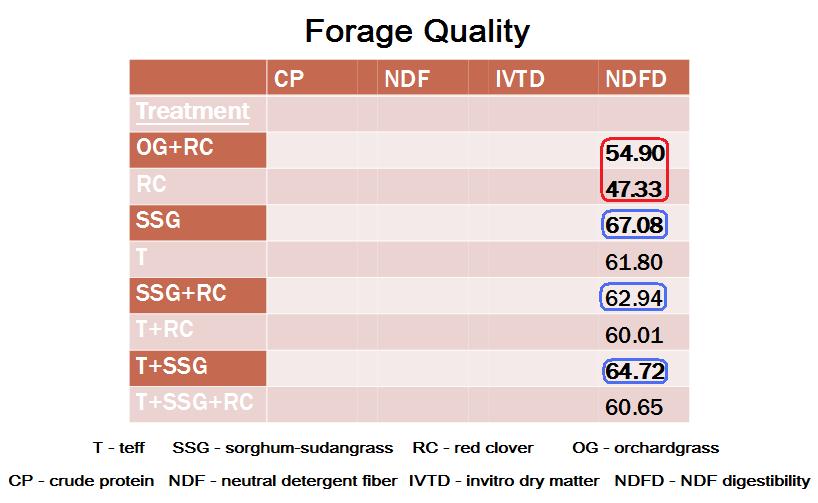
The possible benefits of warm-season annual pastures are:
- Increase available grazing land by pasturing a portion of the field-crop land
- Can be used in field-crop rotation
- More flexibility for farmers using cover crops (using them as forage too, not plow-down only)
- Can be planted as a rescue crop.
Next, Dr. Aimee Hafla, USDA-ARS Animal Scientist, presented Ultra-high Stocking Density Grazing for Dairies. “Mob” or Ultra-high stocking density (UHSD) grazing on western US rangeland is of short duration, with high stocking densities - up to 560,425 kg/ha of livestock, “small” paddocks, and long rest periods (up to 125 days). These rangeland beef producers anecdotally cite greater carry-ing capacity, improved animal production, improved soil quality, improved forage quality, and minimal fixed cost investments (fencing, land, and water).
The objective of this study was to characterize management practices and forage and soil quality on dairy farms using self-described UHSD grazing in PA and NY. Four case studies were done on 4 dairy farms using their version of UHSD for dairy cattle in a more well-watered environment. One sample pasture was selected on each farm (of known size). Data were collected each time the pasture was grazed from June to November 2012 and from April to June 2013. At each farm visit - information on the number of cows grazing, pre- and post- grazed forage height, canopy stratification, and plant tissue samples for forage quality analysis was collected. In May 2013 – soil samples were taken from each pasture.
Each farm varied in their approach to UHSD. One farm moved cows to another paddock only once a day while another moved twice a day and the other two, one moved cows 2-5 times daily and the other 2-3 times daily. The grazing cycle employed was more uniform varying from 28-35 days among 3 of the farms while the other farm was nonspecific “when rested”. In a rainier environment and on cool season dairy pasture, the rest period has to be considerably shorter than on warm season grass rangeland. Forage quality would decline and be inadequate for lactating dairy cows.
The other variable was the amount of forage left after grazing this ranged from a low of 30% remaining to as high as 50%. Supplemental feeding of the cows while on pasture varied considerably from dry hay to silage or hay and silage, or silage and balage. Three of the farms also fed molasses to the cows while the fourth farm fed only salt and mineral. Observed self-described UHSD grazing practices on these dairy farms are:
- Stocking density ranged from 49,421 to 377,912 kg/ha versus rangeland beef UHSD = up to 560,425 kg/ha
- 30 to 49 days between grazing versus rangeland beef UHSD = 90 to 180 days and dairy rotational = 21 day cycle
- Plant height at grazing = 29 cm versus dairy rotational = 15 to 20 cm
- Forage utilization = 45% of total available, similar to dairy rotational, but taller overall residual
- Most forage consumption was from the upper plant canopy.
The grazing dairies observed in this study:
- Have taken a modified approach to current UHSD definitions used in rangeland beef stocking.
- Grazing slightly more mature forages compared to typical dairy intensive rotational stocking.
- Slightly longer rotations than typical dairy intensive rotational stocking
- Unlikely that self-described UHSD grazing occurring on dairies in NY and PA is a superior grazing management technique compared to dairy intensive rotational stocking.
UHSD is a modification of rotational grazing that has been successful on these farms – all of whom are long-time graziers with high levels of management. Further research is needed to examine effects of transitioning to UHSD.
Dr. Les Vough, University of Maryland, rounded out this session. His presentation was Bermudagrass Moving North with Lots to Offer. Bermudagrass in the Mid-Atlantic today has utility in heavy use areas (HUA) and in hay and pasture production. It has the beneficial attributes:
- Warm-season, sod-forming perennial grass to provide grazable grass during summer heat
- Persists under close grazing — 1-2 inches
- Has ability to heal damaged or bare areas (rhizomes & stolons)
- Much more competitive against weeds during hot, dry periods than orchardgrass, tall fescue, and other cool season grasses, and
- Superior species for using nitrogen and phosphorus.
Vegetatively propagated bermudagrass varieties have performed better than seeded varieties. Early efforts with Quickstand for heavy use areas showed promise. However, drawback is the lack of local sources of sprigs (rhizomes and stolons) and sprig planters. Seeded varieties generally have not over-wintered and tend to be less productive. Due to its ability to persist under close-grazing and heavy use areas, it makes a good choice as horse pasture where farm or stable have little pasture acreage.
Current suggested varieties are:
HUA = Quickstand, Patriot (?), Tufcote (?) (Question mark denotes
untested promising variety.)
Hay/pasture = Ozark & Tifton 44 south of I-70, Quickstand (?)
Two techniques for planting sprigs are the use of a no-till sprigger or a standard rear beater manure spreader. The no-till sprigger opens up a slot at intervals, places sprigs in the slot, and then closes the slot over the sprigs. To use a manure spreader, the soil must be tilled first. The manure spreader spreads the sprigs over the prepared soil bed in a series of passes across the field. The sprigs are disced in with a disc harrow and ideally followed by a culti-packer or rolling basket to improve soil to sprig contact. Irrigating a sprigged field enhances rooting establishment of the sprigs and increases sprig survival. Since bermudagrass can send out both underground (rhizomes) and above ground (stolons) horizontal stems, stands that start out thin can eventually cover all the ground it was planted in.
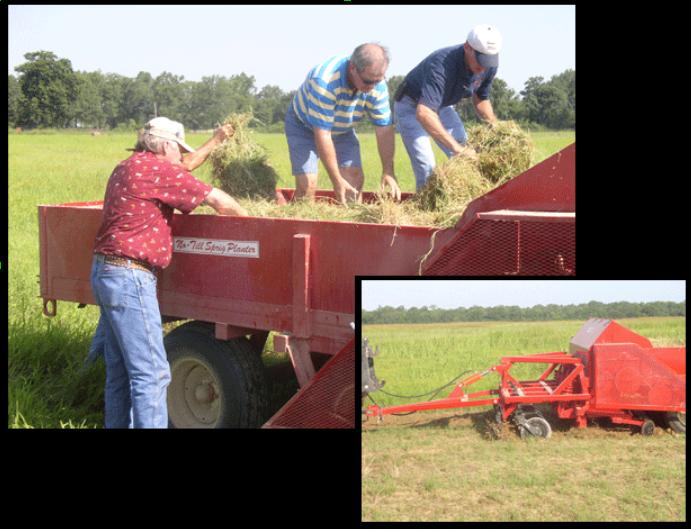
Dr. Andre Brito, University of New Hampshire, was to be the last speaker, but this session ran over in time and had to be ended with Dr. Vough. Here is a brief synopsis of Dr. Brito’s presentation, Effect of Feeding Pasture Supplemented with Ground Flaxseed on Milk Production and Composition in Organic Dairy Cows. The goal of this research is to find out if feeding ground flaxseed to lactating pastured and wintered dairy cows can increase omega-3 fatty acid and conjugated linoleic acid (CLA) in their milk thus providing a milk price premium for organic milk producers while providing beneficial effects on animal health and reproductive efficiency and lowering methane emissions (potent greenhouse gas) from the cows. Two experiments were conducted:
Experiment 1:
Twenty lactating organic Jersey cows received (% of diet dry matter
[DM]): 0, 5, 10, or 15% of ground flaxseed during the winter season.
Experiment 2:
Twenty lactating organic Jersey cows received (% of diet DM): 0 or 10%
of flaxseed during the grazing season.
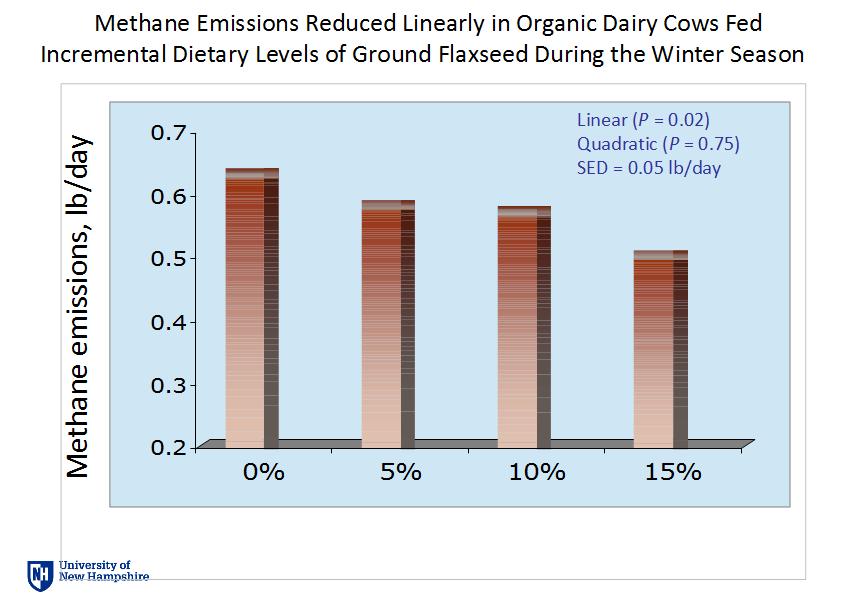
Unfortunately for the wintered cows fed flaxseed, milk production declined from 47 lb/day to 44.5 lb/day from 0 % to 15% of diet DM. However, CLA increased in milk as the diet received more ground flaxseed. Also, milk omega-6 decreased and milk omega-3 fatty acids increased linearly as the diet received more flaxseed improving the the 6:3 ratio making it more healthful to consuming humans. Meanwhile, methane emissions reduced linearly as well in organic dairy cows fed increased dietary levels of flaxseed during Winter.
During the grazing season, 65% of the total diet was forages - 40% pasture and 25% baleage of total diet. The 0% flaxseed diet was rounded out with 1.9% molasses and 33.1% organic grain meal. The 10% flaxseed diet was rounded out with 1.0% molasses, 10% flaxseed, and 24% organic grain meal. Milk production was reduced in organic dairy cows fed ground flaxseed and was affected by month during the grazing season.
On average, milk production declined from 40.1 lb/day with no flaxseed in the pasture diet to 39 lb/day with 10% flaxseed in the diet. Total mixed ration diet declined from 23.9 lb/day with 0% flaxseed in the diet to 23.1 lb/day with 10% flaxseed. Milk fat content in the milk and milk fat yield did not change significantly with the addition of flaxseed in the diet (0% Flax diet = 1.68 lb/day; 10% Flax diet = 1.65 lb/day). Milk fat yield did vary on a month to month basis, however. Milk protein content, too, was similar between diets but it was affected by month during the grazing season (0% Flax diet = 3.43%; 10% Flax diet = 3.47%). Methane emissions were unaffected by level of flaxseed used in the pasture diet.
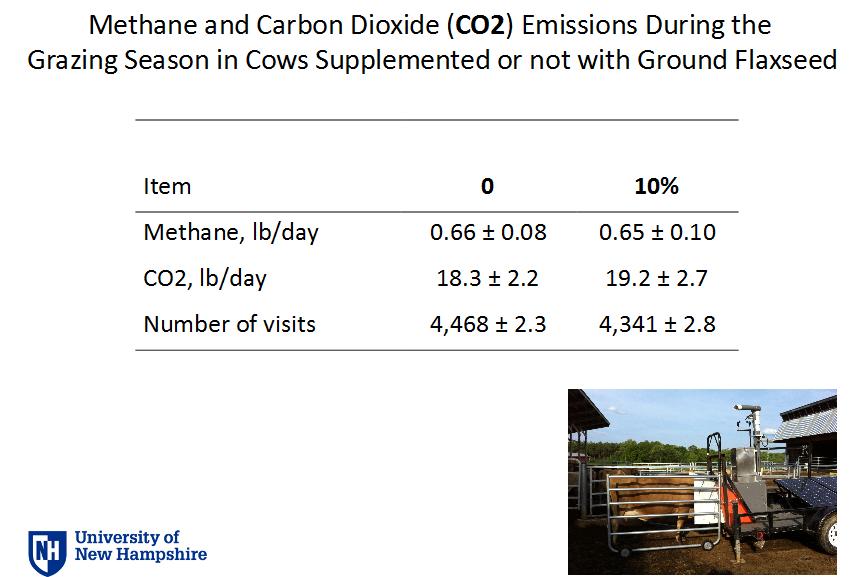
The take home message was:
- Increasing ground flaxseed (i.e., from 0 to 15% of diet DM) reduced milk production and yields and contents of milk fat and milk protein during the winter season.
- However, more dietary flaxseed improved milk fatty acid profile (i.e., more omega-3 and CLA) and reduced methane emissions during the winter season.
- In general, supplementing pasture with ground flaxseed (i.e., 10% of diet DM) did not negatively affect milk yield and composition but did not mitigate methane emissions.